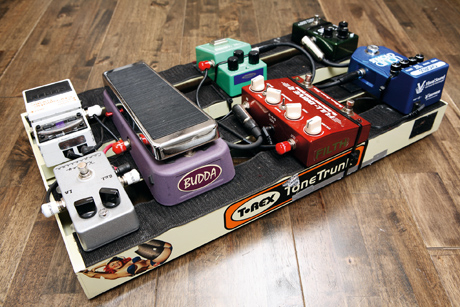FX pedal power supply advice
Gear Tips & Advice: How to choose the right FX pedal power supply for you

The world of amps, guitars, pedals and other gear can be confusing and frustrating at the best of times. Thankfully Guitarist has been around the block a fair few times and is always ready to help you with a gear problem. This week: Alexander McFedries has an issue with pedalboard power supplies…
"I recently bought a BOSS CE-20, and noticed the amount of plugs on the wall was getting ridiculous. I was going to buy a Modtone Power Plant, but in the past I've had trouble buying power supplies, as they don't seem to go with the pedal (making high-pitched noises and so on). How can I be sure no problems will arise if I buy a multi power supply?
"I'm sure this is a common problem for a lot of people, so can you give me some advice? My pedals are an E-HX Micro Synth, an E-HX Graphic Fuzz, a Behringer Heavy Distortion and a BOSS CE-20."
Mick Taylor responds: This is a very common question Alexander, but it has a relatively simple answer, and holds true for any ordinary pedalboard. There are four things you need to know…
1. Voltage - How many volts does the pedal(s) require? One nine-volt supply can drive as many 9V pedals as you like, depending on the…
2. Current - What's the current draw in milliamps? If you're using more than one pedal, add up the total current draw of all your pedals and make sure your chosen supply can put that out. Also be sure to check the maximum current for each separate outlet on the supply.
For example, the supply might be capable of delivering 1000mA in total, but only 200 max per outlet. That would be fine for the majority of 'normal' pedals, such as your CE-20 at 160mA, but there are numerous pedals that require more.
Get the MusicRadar Newsletter
Want all the hottest music and gear news, reviews, deals, features and more, direct to your inbox? Sign up here.
3. Connection type - What type of plugs/pins are required?
4. Polarity - Centre-negative or centre-positive?
You also need to consider noise and interference: most higher-end power supplies have isolated outputs, which can help to minimise the kind of annoying and unwanted noises you're describing.
If you know all of the above, you know what kind of power supply you need. The depressing truth is that if you have mixed voltages/high current and/or different polarity requirements - and you want isolated outputs - it's going to cost you some cash.
The Modtone Power Plant's 9V DC outs are regulated at 150mA each so, on paper at least, wouldn't be enough for the CE-20, for example. The Micro Synth's recommended supply is 9.6 volts, 200mA. In short, it's not looking like the ideal choice.
Supplies that are better on paper are the Voodoo Lab Pedal Power 2 Plus or the new T-Rex Fuel Tank Chameleon. The Chameleon will be reviewed in a forthcoming issue of Guitarist, look out for it!
“A pedal that sings with harmonic richness and blooming touch response”: Tone King offers up boutique tube amp tones for your pedalboard with the Imperial Preamp
“Each and every unit is perfectly dialled in to the 'sweet spot' that can be so elusive to find in vintage pedals”: Pigtronix’s Gas Giant is a high-gain fuzz pedal with a FET-driven onboard noise gate









